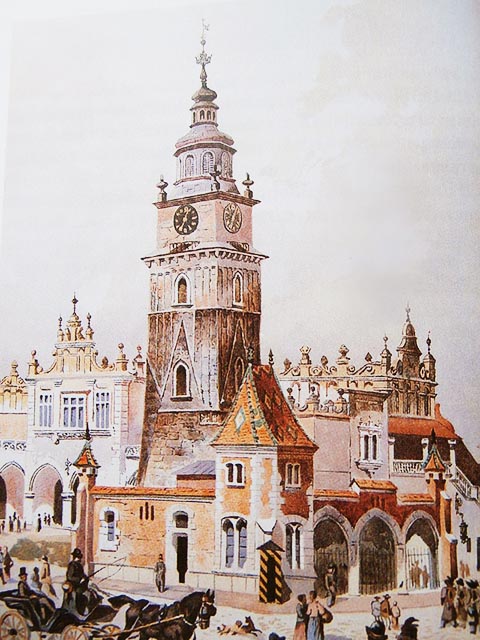 Wieża Ratuszowa
Wieża Ratuszowa
W zachodnim narożniku Rynku tkwi samotna, ale za to pięknie odnowiona Wieża Ratuszowa – wspomnienie po średniowiecznej siedzibie władz miejskich. Cały kompleks wybudowano na przełomie XIII i XIV w., jednak z powodu zniszczeń ratusz rozebrano w 1818 r. Wieża liczy sobie 70 m wysokości i – co ciekawe – ma 55 cm odchylenia od pionu. Wejścia od strony północno-wschodniej strzegą dwa leżące lwy, bardzo już zagłaskane. W odrestaurowanych wnętrzach urządzono oddział Muzeum Historycznego miasta Krakowa, w którym gromadzono pamiątki związane z działalnością rajców miasta. Poza tym organizuje się tutaj wystawy sztuki współczesnej. Warto wspiąć się po 91 stopniach, aby wkroczyć do świetnej sali i z jej trzech wielkich okien podziwiać panoramiczny widok na miasto: widać stąd dachy, mansardy i wieże kościołów. Zdobiące ściany unikalne zdjęcia w sepii tworzą ciekawą ekspozycję: Krakowski Rynek w starej fotografii. Niestety, zwiedzanie muzeum jest utrudnione ze względu na prawie nieustający remont wieży. W ratuszowych podziemiach działa pub Stańczyk oraz oddział krakowskiego Teatru Ludowego – Scena pod Ratuszem.
Od wieku XIV w Ratuszu, gdzie urzędował magistrat, rada, kasa, lawa i sad, z całą pewnością skupiało się życie miejskie, ale nie tylko to oficjalne i nobliwe. Od północnej strony Ratusza 'hulała’ piwnica Świdnicka, prawdziwy klub towarzyski średniowiecznego Krakowa, gdzie serwowano świetne piwo importowane ze Świdnicy. W 1540 r. piwnice zamknięto jednak w trosce o moralność, a sam Andrzej Frycz-Modrzewski gorszył się w te słowa: „Ludzie próżnujący cały dzień tam przeleżą, piją a żywią się z nierządnicami bardzo rozpustnie…”
W podziemiach Ratusza mieściło się wiezienie, skąd wiodły trzy drogi: na wolność, na egzekucje (ścięcie, powieszenie, ćwiartowanie, wbijanie na pal, spalenie, wplatanie w koło) lub w objęcia katów specjalizujących się w torturach. Pozbawienie wolności, czyli odsiadka, było stosowane bardzo rzadko. Kary, wykonywane w więziennych izbach tortur, sąsiadujących przez ścianę z piwnicą Świdnicka albo na Rynku, były tak różne, jak opinie o średniowieczu. Oprócz prozaicznych, jak na przykład zakuwanie w kuny, czy obcinanie rąk albo uszu, stosowano kary hańbiące, i tak za zabójstwo krewnego, winowajcę zaszytego w worek razem z kurą, psem i jaszczurką wrzucano do rzeki. Lekką karą było ośmieszenie, kiedy winny musiał jeździć po Rynku na ośle lub nosić kamień.
Aby wymusić na więźniach zeznania lub przyznanie się do winy, smarowano ich ciała siarką, lano do gardła wrzątek, ocet lub gorący olej, albo na pępek kładziono myszy czy szerszenie i przykrywano je naczyńkiem. Wyroki ferowali ławnicy. Przepisy dbały o to, aby sądzono surowo, lecz obiektywnie. Na przykład ławnikom nie wolno było sądzić na czczo, gdyż taki stan mógł niekorzystnie wpłynąć na wyrok.